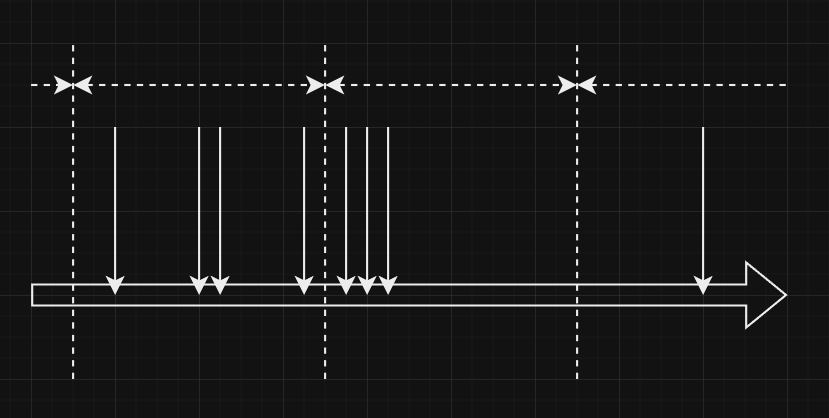PY 3. API Rate Limiter
안녕하세요. 이번 글에서는 API Limiter에 대해서 다뤄보려고 합니다. Python에 특화된 주제는 아닌데, 그냥 구현을 Python으로 하다보니 Python 시리즈에 글을 쓰게 되었습니다. 만약 나중에 이 글을 넣기 적합한 다른 시리즈가 나온다면 그쪽으로 글을 옮길 수도 있습니다.
API limiter¶
API Limiter는 API를 제공하는 서비스에서 무분별한 스팸 요청을 막기 위해 만드는 장치입니다. 시간당 API 요청 개수에 제한을 거는 대표적인 서비스로는 코인거래소 Binance가 있으며, Binance Spot Exchange API Docs 등에서 자세한 사항을 확인하실 수 있습니다.
Basic parameters¶
API 제한을 만드는 데 들어가는 요소들은 크게 다음과 같은 것들이 있습니다.
- Interval: API 제한 시간. 예를 들어 어떤 API는 1시간 당 요청 횟수로 제한을 책정하고 경우에 따라 1분 당 요청 횟수를 사용하는 곳도 있습니다.
- Capacity:
Interval만큼의 제한 시간 동안 몇 번의 요청을 보낼 수 있는지를 의미합니다.
예를 들어, 1분 당 30번의 요청까지만 허용하는 API의 Interval은 3분, Capacity는 30번인 셈입니다.
그리고 이 제한은 한 API에 대해 여러 번 중첩되어 기록될 수 있습니다. 예를 들어 1시간 당 3600번의 요청 상한을 두고 동시에 1분 당 600번의 요청 상한을 둘 수 있습니다. 이것은 rate limit이 한 API에 2중으로 걸려있는 것에 불과하며, 개별적인 제한에 대한 구현만 진행하면 큰 어려움 없이 복잡한 제한도 구현할 수 있습니다.
Implementation methods¶
어떤 API의 시간 당 요청 횟수를 측정하는 기준도 정의하기 나름입니다. 저는 다음 방법들을 제시합니다. 어느 쪽이 무조건 옳다라는 정답은 없습니다. 서비스의 특성이나 API의 민감도에 따라 다른 기준을 정의할 수 있을 것입니다.
Simple resetting¶
기준이 되는 시간마다 API 요청 횟수를 초기화시키는 방식입니다. 아마 가장 간단한 구현방식이자 동시에 제일 적은 리소스를 사용하는 방식일 겁니다. 이 구현이 간단한 이유는 가장 마지막에 요청이 들어온 시각과 카운팅 횟수에 대한 정보만 알면 알고리즘이 작동하기 때문입니다. 하지만 이 방식의 잠재적인 단점은 API 요청 횟수가 초기화될 무렵 즈음에 컴퓨팅 및 I/O 부하가 잠깐 일어날 수 있다는 것입니다. (트래픽이 엄청 크지 않은 이상 이게 유의미한 문제점이 될 지는 모르겠지만요..)
Caption
알고리즘을 시각화한 이미지입니다. 일정한 시간 간격 안에서만 API request 횟수가 유효하며, 어떤 사이클을 지나고 새로운 사이클에 진입할 경우 API request 횟수는 초기화됩니다.
from datetime import datetime, timedelta
class RateLimiterCycled:
"""
Rate limiter using the simple resetting method.
"""
def __init__(self, interval: timedelta, capacity: int):
self._interval = interval
self._capacity = capacity
self._last_requested: datetime = datetime.min
self._count: int = 0
def is_new_cycle(self, timestamp: datetime) -> bool:
"""
Check if this timestamp is from a new cycle.
"""
since_new_cycle = timedelta(
seconds=timestamp.timestamp() % self._interval.total_seconds(),
)
return timestamp - since_new_cycle > self._last_requested
def request(self, timestamp: datetime) -> bool:
"""
Register a request and return whether it is allowed or not.
"""
# Fail if the timestamp is not in order(same timestamp is allowed)
if self._last_requested > timestamp:
return False
# Fail if overflowed on same cycle
is_new_cycle = self.is_new_cycle(timestamp)
if not is_new_cycle and self._count >= self._capacity:
return False
# Update last requested timestamp and count then return success
self._last_requested = timestamp
if is_new_cycle:
self._count = 0
self._count += 1
return True
Sliding window¶
일정한 단위시간 기준이 아닌, 그 어떤 연속적인 interval을 고르더라도 그 안에 capacity 개수 이상의 request가 없음을 보장하고 싶다면,
Sliding window 알고리즘을 사용하여 이를 해결할 수 있습니다.
구현 방식은 조금 복잡합니다.
왜냐하면 연속적으로 들어온 요청들의 timestamp 정보들을 전부 저장하고 오래된 timestamp들을 순차적으로 삭제할 수 있어야 하기 때문입니다.
이는 deque 등을 사용하여 효율적으로 구현할 수 있습니다.
Caption
알고리즘을 시각화한 이미지입니다.
개별 request마다 정보가 기억되는 일종의 "유통기한"이 다릅니다.
이 알고리즘을 구현할 경우 timeline 상에서 그 어떤 연속적인 interval을 고르더라도 capacity 개수 이상의 request가 없음이 보장될 수 있습니다.
from collections import deque
from datetime import datetime, timedelta
class RateLimiterContinuous:
"""
Rate limiter that guarantees no overflow on any continuous time interval.
"""
def __init__(self, interval: timedelta, capacity: int) -> None:
self._request_timestamps: deque[datetime] = deque()
self._capacity: int = capacity
self._interval: timedelta = interval
def get_last_request_timestamp(self) -> datetime:
"""
Return the timestamp of the last request.
"""
return (
self._request_timestamps[-1]
if self._request_timestamps
else datetime.min
)
def request(self, timestamp: datetime) -> bool:
"""
Register a request and return whether it is allowed or not.
"""
# Fail if the timestamp is not in order(same timestamp is allowed)
if self.get_last_request_timestamp() > timestamp:
return False
# Remove old expired timestamps
while (
self._request_timestamps
and self._request_timestamps[0] < timestamp - self._interval
):
self._request_timestamps.popleft()
# Fail if the queue is still full
if len(self._request_timestamps) >= self._capacity:
return False
# Add the request timestamp and return success
self._request_timestamps.append(timestamp)
return True
Notes on lazy evaluation¶
위 구현들은 매 정각마다 실시간으로 횟수가 업데이트 되는 개념이 아닌, 요청이 들어올 때마다 뒤늦게 시간/횟수 관련 정보를 업데이트하는 것을 보실 수 있습니다. 실제로 요청이 자주 이루어지지 않는 API들의 정보까지 실시간으로 업데이트할 필요가 없습니다. API request가 들어오면 그때 기존의 expired된 request timestamp들을 처리하더라도 계산량의 총량에는 변화가 없기 때문입니다.
지금까지 API limiter를 구현하는 방법들에 대해 알아보았습니다. 정말 오랜만에 블로그 글을 썼네요.. 글을 읽어주셔서 감사합니다.

